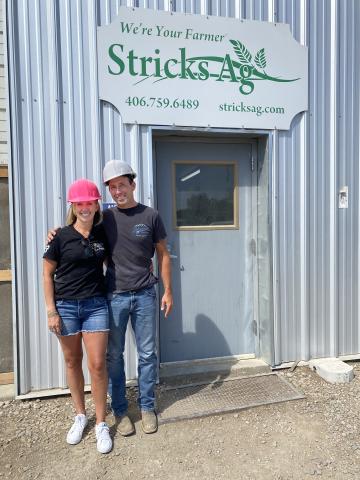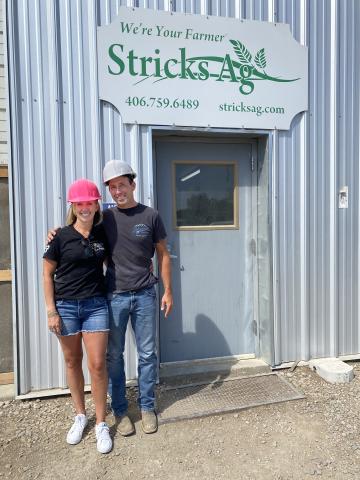Chickpeas can bolster soil nicely being. For one family, the tiny legumes have turn into a medium to develop group and dialog.
Beneath expansive blue skies and rolling grass plains in Chester, Montana, a positive farm is modeling healthful relationships among the many many producers, distributors, and land. Tyler Streit is a fifth-generation farmer, who used to monocrop wheat all through his family’s 20,000 acres, regarding the dimension of Manhattan. In the intervening time, collectively along with his partner Jill Streit, they develop 19 completely completely different crop varieties, adjust to regenerative agriculture practices, and model communicative relationships all via the agricultural present chain.
The Regenerative Transition
Historically, the Streits farm adopted industrial agriculture norms: making use of synthetic fertilizers, spraying chemical substances to keep up out weeds and pests, and plowing fields yearly. They didn’t perceive that this course of killed virtually all the microorganisms throughout the soil—solely leaving about half a p.c, Tyler estimates. Pure matter is important for moisture retention, nutritional vitamins, and carbon sequestration. Healthful soil has roughly 2-8% pure matter, in accordance with the Faculty of Minnesota, along with appreciable underground natural train, similar to from fungi and earthworms.
“We’ve constructed just a few of that pure matter as a lot as 3%. Our goal is to have it at 5%,” says Tyler.
Inside the early 90s, Tyler’s father Leonard decided to attempt a no-till program and Tyler and Jill started diversifying their crops throughout the early 2000s. Together with pulses to their crop rotation—chickpeas, peas, and lentils—helped to create extra wholesome soil. These crops restore atmospheric nitrogen into the soil, which is an important nutrient for crops to develop, and thus reduces the need for synthetic fertilizers.
The farm has been using primarily its private saved seeds for years. Sowing seeds from earlier generations is crucial to native climate resiliency since each period turns into coded with mandatory environmental data to survive the next 12 months and the 12 months after that. In the last few years, the Streit farm has moreover eradicated synthetic seed therapies (dealt with seeds have chemical substances or completely different synthetic provides utilized to the floor to boost their potential to develop) and fungicides from all their fields.
The farm is totally completely completely different for the time being than the best way it was when Tyler’s mom and father and grandparents ran it, he says.
“Now it’s a transition of the mindset to not merely producing, nevertheless how we produce,” Jill offers. “Our downside is to find out the most effective methods to work all through the ecosystem, to regenerate the soil and have the power to provide points which have additional vitamin.”
A Neighborhood to Promote the Producers
When the Streits started rising pulses, a type of legume, they realized quickly that the markets to advertise these crops have been small in Montana, so that they decided to create a spot to course of and promote domestically. They took a leap of faith and started a pulse-processing facility in 2014 with the Wicks family, making a model new enterprise known as Stricks Ag.
“We risked masses and started working in that space the place we now have been actually searching for merchandise, not solely from ourselves, nevertheless from completely different producers, packaging them and selling them out into the market space,” says Jill.
The presence of the ability has given native farmers the prospect in order so as to add pulses to their topic rotations and plug into the Streits’ group to advertise their merchandise. Altogether, the Streits have influenced 300 producers in order so as to add pulses to their farms.
Whereas the ability has helped farmers diversify their crops, it’s moreover given Jill and Tyler the prospect to share what they’ve realized about regenerative farming. They host weekly growers conferences throughout the winter, along with additional conferences and topic days all yr lengthy to indicate completely different farmers their data.

The heartbeat-processing facility opened a whole lot of doorways for Tyler and Jill as communicators and network-builders amongst chickpea farmers and patrons, along with Banza, a company that makes merchandise like pasta, pizza, and mac & cheese out of chickpeas, and is part of Inexperienced America Soil Carbon Initiative’s Go-To-Market Pilot. Tyler and Jill are moreover part of the Pilot, which provides them a spot to tout some great benefits of regenerative farming and present the value of regenerative meals with the SCI label.
Actual Connection
Banza was launched to Tyler in 2017 by the use of the Redwood Group, which is a commodity present chain confederate with an enormous group of farmers. Banza representatives immediately acknowledged that the Streits have been in distinction to completely different farmers: devoted to soil nicely being and the well-being of producers.
The connection that Banza and the Streits have normal is in distinction to many throughout the commerce, the place farmers normally don’t get to have a relationship with the tip producer or purchaser. Tyler and Jill spend a wide range of time talking with producers like Banza so companies are aware of the state of the farms and the ebbs and flows of chickpea yields and prices.
Sophie Rifkin, senior director of sustainability at Banza, says that Banza values the exhausting work and partnership of growers like Jill and Tyler who’re open to enhancing soil nicely being on account of it helps their focus to boost sustainability of their present chain.
“What it has accomplished is created additional stability of their manufacturing, [because Banza is prepared for low yield years,] and it has created additional stability in our potential to produce the merchandise, determining that now we now have a market to go to,” says Jill. “Every time I see a subject of Banza on the shelf, I’ve pleasure. As a producer, that’s good to know that our merchandise are in that subject feeding the world a extra wholesome product.”
Furthermore, Inexperienced America’s Soil Carbon Initiative opens new pathways for Banza and the Streits as they proceed to develop sustainable and regenerative practices all via their operations. “When Banza first realized regarding the SCI program and decided to affix the pilot, we immediately thought of partnering with Jill and Tyler,” says Rifkin. “A majority of those collaborations are wished to help advance new strategies of farming.”
With the group they’ve established, by the use of SCI and of their group, the Streits hope to share their story so that patrons acknowledge the importance of regenerative chickpeas and encourage completely different farmers to undertake regenerative farming practices.
“If we’ll get growers to make a few little modifications, we’ll make an enormous impact [on the environment],” says Jill. “An a-ha second was not merely that we might do it on our private farm, nevertheless that if all of us did it, the excellence it would make.”
